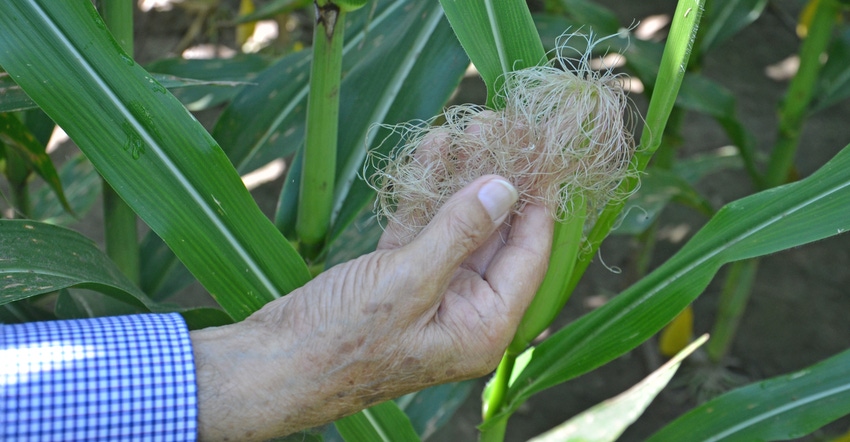
If you must see to believe, this example is for you. A plant in the Corn Watch ’20 emergence plot was flagged as emerging a couple of days after its neighbors. That may not seem like a big deal. In this case, Dave Nanda says it will be the difference between a plant that contributes to yield and a plant worse than a weed.
“This plant used up nutrients and moisture which could have gone to neighboring plants if it wasn’t there,” says Nanda, director of genetics for Seed Genetics Direct. Corn Watch ’20 is sponsored by Seed Genetics Direct, based near Jeffersonville, Ohio.
You may still be wondering what Nanda means. The plant he is referring to (pictured above) is putting on an ear. Isn’t that a good thing?
“The goal of any corn plant is to produce progeny, if possible, and as many progeny as possible,” Nanda says. “That’s why it has put on an ear.
“Take a close look at the silks. They are several inches long and still green. That means they’re not pollinated. If pollen grains don’t find silks, they [the silks] keep growing, hoping sooner or later to get fertilized.”
Solve the pollination mystery
So, if the plant put on an ear and the ear is producing silks, why isn’t it pollinated? Why will it produce few, if any, kernels?
“This plant was so far behind in its growth pattern that when the ear finally silked, other plants around it were finished shedding pollen,” Nanda explains. “I examined several tassels near this plant just to confirm it. All of them had already shed pollen. There was no pollen left. The silks on most of the ears on other plants around this one were already turning brown. Silks turn brown after pollination is successful and kernels are beginning to develop on the ear.”
Ah, you’re probably ready to ask a very logical question. If this late-emerging, smaller plant produced an ear, and the ear produced silks, didn’t it produce a tassel too? Couldn’t it pollinate itself? Why did it need to rely on pollen from other plants?
“It did produce a tassel, but it was tiny,” Nanda says. “It wasn’t going to be able to pollinate itself. That’s why it needed pollen from other plants. But by the time silks began growing out of its small ear, there simply wasn’t any other pollen in the vicinity to pollinate the plant.”
The result will likely be a small, slender plant at harvest, with an ear with no or very few kernels. In all likelihood, it will be a barren cob.
“So, it took away nutrients which could have helped neighboring plants pack more starch into kernels,” Nanda says. “That’s why I contend that if you have a plant which is so far behind it can’t contribute, you are better off with no plant and a gap in the row. Then the plants on either side will compensate to some degree and produce bigger kernels.
“You can take weeds out with herbicides. But there’s no way to take a nonproductive corn plant out. That’s why I say these plants are worse than weeds.”
About the Author(s)
You May Also Like




